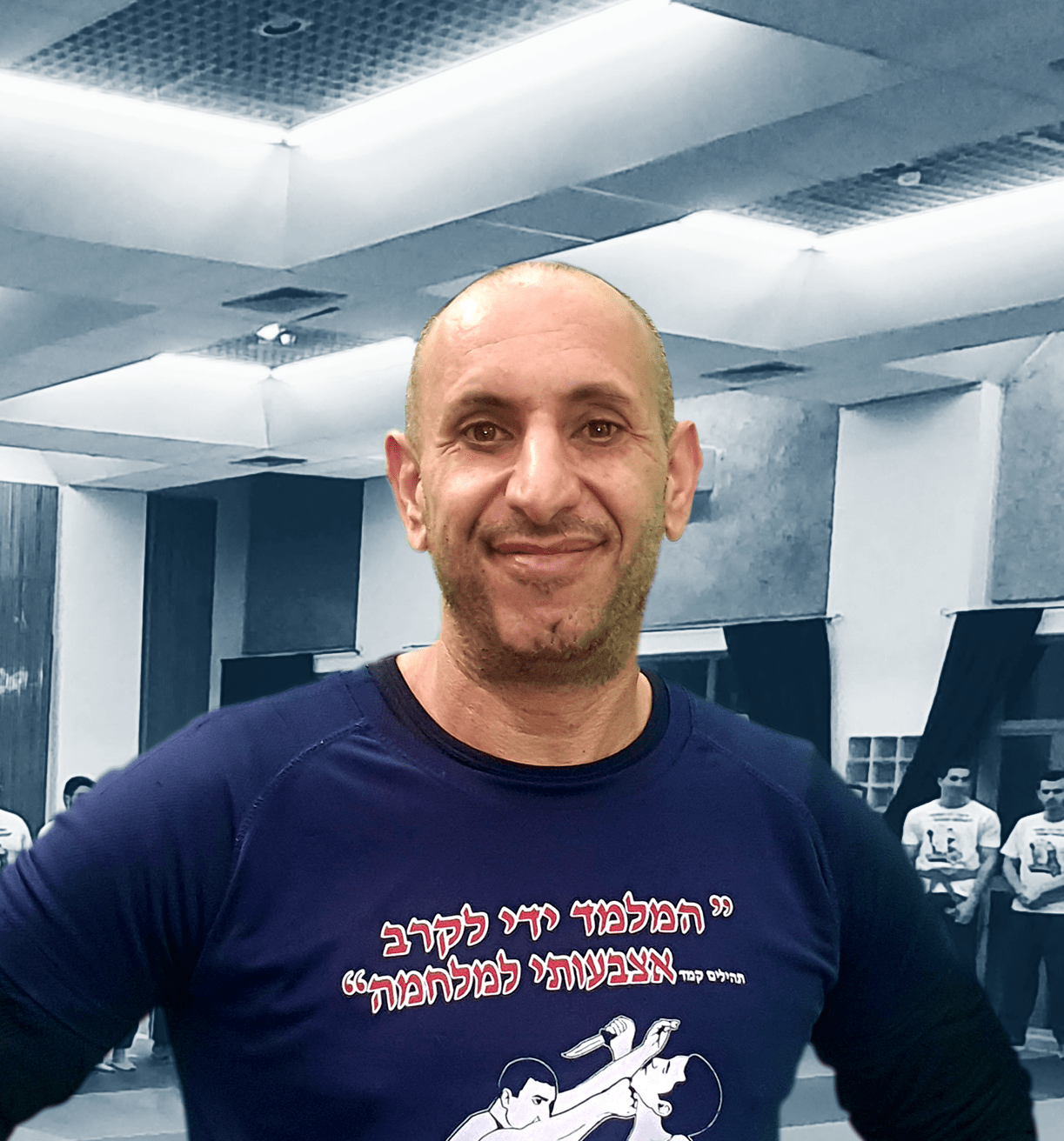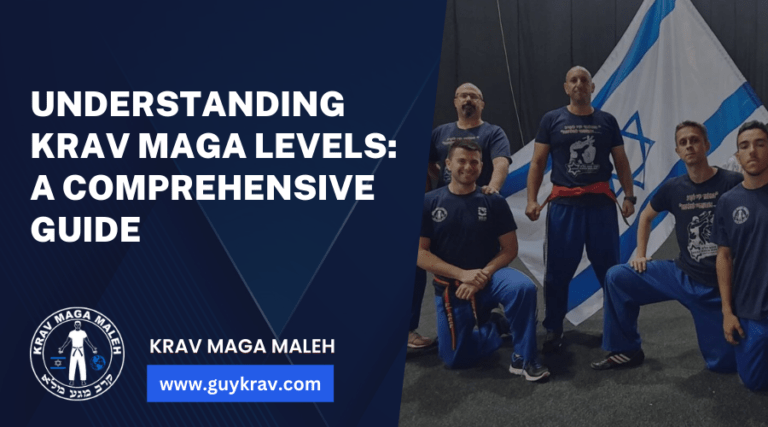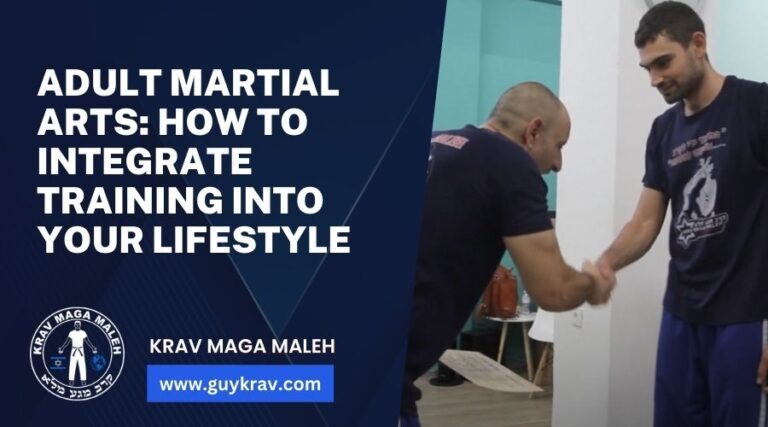Have you ever wondered about the journey through Krav Maga levels? Krav maga, a powerful self-defense system, offers more than fighting skills. It’s a path of personal growth, discipline, and mastery. Each level in Krav Maga represents a new set of challenges and achievements. But what does it take to move from one level to the next? And how can understanding these levels help you in your training?
In this article, you’ll discover
- The meaning behind each Krav Maga level and the skills you’ll learn.
- The belt system that marks your progress in Krav Maga.
- Tips for training and preparing for your next Krav Maga grading.
- How Krav Maga levels can enhance your fitness, confidence, and self-defense capabilities.
Whether you’re a beginner curious about starting Krav Maga or an experienced practitioner aiming for the next level, this guide has something for you. By understanding the structure and requirements of Krav Maga levels, you’ll be better equipped to set goals and achieve them. Plus, you’ll gain insight into how Krav Maga training can benefit your overall well-being and self-defense skills.
Are you ready to dive deeper into the world of Krav Maga levels and see how far you can go? Keep reading to unlock the secrets of progressing in Krav Maga and how it can transform your life.
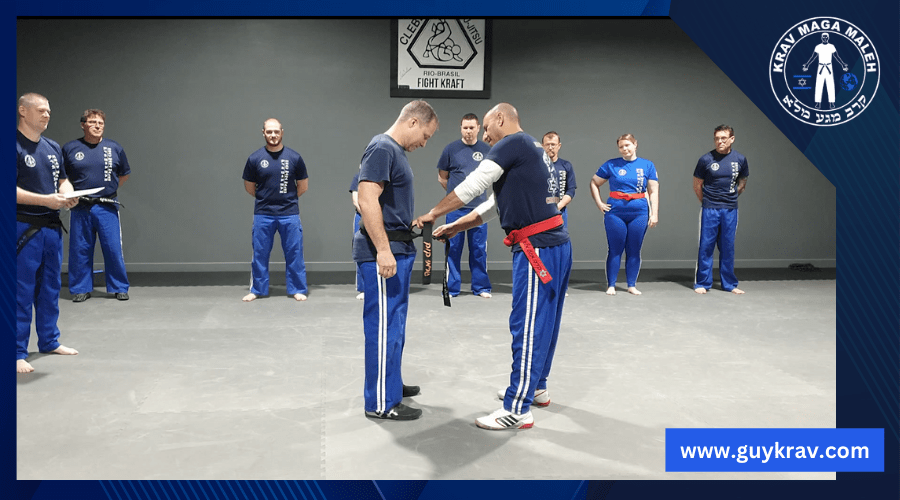
The Fundamentals of Krav Maga Levels
Overview of Krav Maga Levels
Krav Maga, a martial art known for its focus on real-world situations and efficient self-defense, breaks down its training into Krav Maga levels. Each level builds upon the last, ensuring that students develop a comprehensive skill set. Here’s a quick look at what each level entails:
- Beginner Levels (White and Yellow Belts): Students start their journey learning the basics, such as stance, movement, and simple defensive techniques. This foundation is crucial for all Krav Maga practitioners.
- Intermediate Levels (Orange and Green Belts): At this stage, the focus shifts to more advanced strikes, self-defense techniques, and beginning ground fighting. Students learn to defend against weapons and multiple attackers.
- Advanced Levels (Blue, Brown, and Black Belts): Advanced students master complex fighting skills and self-defense strategies. Training includes dealing with high-risk situations and enhancing physical conditioning.
Each level in Krav Maga is not just about learning new techniques; it’s about personal growth, improving fitness, and building confidence. Students face new challenges that test their skills and resilience as they progress. Achieving a new belt is a significant milestone, reflecting dedication, skill improvement, and a deeper understanding of Krav Maga’s principles.
Training for these levels involves a mix of technique refinement, sparring, and physical conditioning exercises. Instructors emphasize the importance of mental toughness and situational awareness, preparing students for real-life scenarios. This holistic approach ensures that Krav Maga practitioners are not just fighters but also protectors, capable of defending themselves and others.
Preparing for Krav Maga grading is a rigorous process. It requires consistent practice, a deep understanding of the techniques for each level, and the ability to apply them under pressure. Grading sessions are comprehensive evaluations where students demonstrate proficiency in the skills required for their current level, aiming to advance to the next.
The Purpose Behind the Level System
The level system in Krav Maga serves several important purposes, each designed to enhance the learning experience and ensure the effectiveness of training. Let’s explore why this structured approach is so crucial:
- Structured Progression: The level system offers a clear path for students, from beginners to advanced practitioners. It ensures that each learner builds on solid foundations before moving on to more complex techniques. This progression is key to developing effective self-defense skills.
- Motivation and Goal Setting: Achieving a new belt or level provides a tangible goal for students to aim for. It’s a milestone that signifies improvement and mastery over certain aspects of Krav Maga. This system keeps students motivated and focused on their training journey.
- Safety and Preparedness: By gradually increasing the complexity of techniques and scenarios, the level system ensures that students are not exposed to situations they’re not ready to handle. This approach prioritizes safety while preparing students for real-life self-defense situations.
- Personalized Learning: Recognizing that students progress at different rates, the level system allows for personalized learning experiences. Instructors can tailor training and feedback to meet the needs of each student, ensuring that everyone reaches their full potential.
- Quality and Consistency: The level system maintains high standards of quality and consistency in Krav Maga training. It ensures that all students, regardless of where they train, receive the same level of instruction and meet the same criteria to progress.
- Community and Belonging: Working towards common goals creates a sense of community among students. The level system fosters a supportive environment where practitioners can share experiences, challenges, and achievements, strengthening the bond within the Krav Maga community.
In essence, the level system in Krav Maga is more than just a way to organize training. It’s a comprehensive approach that supports learning, motivation, safety, and community. By understanding the purpose behind this system, students can better appreciate their journey and the goals they’re working towards.
Detailed Look at the Krav Maga Belt System
The Krav Maga belt system is a key part of understanding how students progress in their training. Each belt color represents a new stage of learning, skill, and personal development. Let’s take a closer look at what each belt means and the journey students undergo.
- White Belt: The starting point for all Krav Maga practitioners. At this level, students learn the basics of stance, movement, and fundamental self-defense techniques. It’s all about laying the groundwork for future learning.
- Yellow Belt: Moving up, the yellow belt introduces students to more complex techniques, including defenses against grabs and basic attacks. The focus is on building confidence and reaction speed.
- Orange Belt: At the orange belt level, students start to practice defenses against weapons and multiple attackers. This stage emphasizes situational awareness and the ability to respond effectively under stress.
- Green Belt: Green belt practitioners dive deeper into advanced striking and grappling techniques. Training becomes more intense, preparing students for real-world self-defense scenarios.
- Blue Belt: The blue belt level is where students refine their skills and begin to master combat and fighting strategies. The emphasis is on fluidity, precision, and tactical thinking.
- Brown Belt: Approaching the pinnacle of Krav Maga training, brown belt students focus on high-level self-defense techniques, including protection against armed threats. Physical and mental toughness are key.
- Black Belt: The black belt is the highest achievement in Krav Maga, symbolizing expertise, dedication, and a deep understanding of the art. Black belt practitioners are capable of teaching others and continue to learn and grow themselves.
Each belt in the Krav Maga belt system is not just a marker of skill level but a milestone in a practitioner’s journey. Achieving a new belt is a moment of pride and a testament to the hard work, dedication, and perseverance of the student. It’s a journey that challenges both the body and the mind, fostering growth, resilience, and a profound sense of achievement.
The belt system also ensures that training is structured and progressive, allowing students to build on their skills systematically. This structured approach is essential for effective learning and ensures that students are always prepared for the challenges of each new level.
From White to Black: The Meaning Behind Each Belt
The journey from white to black belt in Krav Maga is not just about learning new moves. It’s about growing stronger, both inside and out. Each belt color has its own meaning and represents a step forward in the practitioner’s journey.
- White Belt: This is where everyone starts. It symbolizes a blank slate or beginning. Students learn the basics of Krav Maga, including stance, movement, and how to stay safe.
- Yellow Belt: Yellow represents the first rays of sunlight, giving light to the student’s path. Here, the focus is on learning how to respond to attacks and developing reaction times.
- Orange Belt: Orange is for creativity and adaptability. Students start dealing with more complex scenarios, including defenses against weapons.
- Green Belt: Green stands for growth. At this level, students expand their knowledge into advanced techniques and start to understand how to control an opponent.
- Blue Belt: Blue symbolizes depth and stability. Skills in tactical thinking and combat strategies are honed, preparing students for more advanced challenges.
- Brown Belt: Brown represents maturity and the earth. It’s about grounding oneself in the art, mastering self-defense against various threats, and helping others learn.
- Black Belt: Black signifies mastery and the journey’s beginning, not the end. Black belt practitioners continue to learn, teach, and refine their skills, embodying the true spirit of Krav Maga.
Key Techniques and Skills at Each Belt Level
Each belt level in Krav Maga introduces new techniques and skills, building on what was learned previously.
- White Belt: Students start with basic stances, punches, and kicks. They learn how to fall safely and get up quickly.
- Yellow Belt: The focus shifts to defending against grabs and headlocks, as well as basic ground defense.
- Orange Belt: Techniques become more complex, including defenses against weapons like sticks and knives. Students also learn to deal with multiple attackers.
- Green Belt: This level introduces advanced striking and grappling techniques. Students practice fighting from different positions and controlling an opponent on the ground.
- Blue Belt: Students refine their fighting skills, learning advanced combinations and counterattacks. They also work on defensive tactics against armed threats.
- Brown Belt: At this level, the focus is on high-level self-defense techniques, including protection against firearms. Students also learn to lead and teach others.
- Black Belt: Black belt practitioners focus on mastering the art, including third-party protection and advanced fighting strategies. They also dedicate time to teaching and mentoring lower-level students.
The progression through the Krav Maga belt system is a journey of personal and physical development. Each belt brings new challenges and achievements, pushing students to grow in their practice and as individuals.
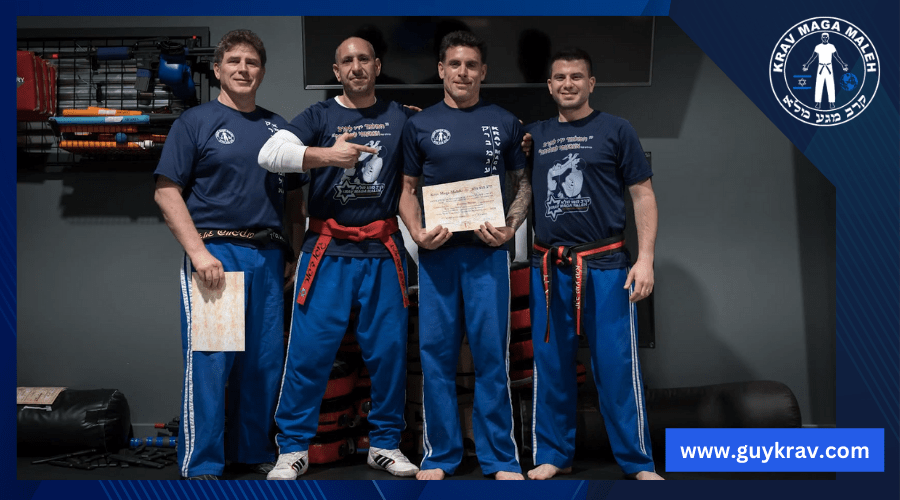
Krav Maga Level Requirements and Training Focus
Beginner Levels: Foundations and Basic Techniques
At the heart of Krav Maga training, beginner levels are where the journey begins. These levels, typically encompassing White and Yellow Belts, focus on laying a solid foundation for all future learning. Here, students get introduced to the core principles of Krav Maga, emphasizing self-defense, awareness, and physical conditioning.
- Stance and Movement: The first step is mastering the basic stance and movement. This is crucial for maintaining balance and mobility during a confrontation. Students learn how to position their bodies effectively to defend themselves or prepare for an attack.
- Strikes: Beginners are taught simple yet effective striking techniques. These include punches, palm strikes, and elbow strikes. The goal is to enable students to deliver powerful and precise strikes in any situation.
- Defensive Techniques: Basic defensive moves form a significant part of the curriculum at this level. Students learn how to block or deflect attacks, focusing on common threats like punches and kicks. This training also covers how to escape from grabs and chokes.
- Situational Awareness: A key aspect of Krav Maga is being aware of one’s surroundings to prevent or prepare for potential threats. Beginners are taught to observe their environment and assess situations quickly and calmly.
- Physical Conditioning: To effectively perform Krav Maga techniques, students must be in good physical shape. Thus, conditioning exercises are integrated into training sessions to build strength, endurance, and agility.
The beginner levels are designed to be accessible to people of all fitness levels and backgrounds. Instructors emphasize a supportive and encouraging environment where students can learn at their own pace. The focus is not just on techniques but on building confidence, discipline, and a mindset geared towards self-defense and personal safety.
By the end of the beginner levels, students should have a firm grasp of Krav Maga’s basic principles and techniques. They should feel more confident in their ability to defend themselves in a variety of situations and be prepared to advance to the next level of training. The journey through Krav Maga is as much about personal development as it is about acquiring self-defense skills.
Krav Maga Level Requirements and Training Focus
Beginner Levels: Foundations and Basic Techniques
At the beginner levels, Krav Maga students focus on building a solid foundation. This stage is crucial for understanding the principles behind Krav Maga and preparing for more advanced training. Here’s what beginners work on:
- Stance and Movement: Learning the correct posture and how to move effectively is key. This forms the basis for all future techniques.
- Basic Strikes: Punches, kicks, and other striking techniques are introduced. Students learn to deliver these with power and precision.
- Defensive Techniques: Beginners are taught how to defend against common attacks, such as grabs and chokes.
- Situational Awareness: Understanding one’s surroundings and identifying potential threats is a critical skill developed early on.
Intermediate Levels: Advanced Techniques and Strategy
As students progress to the intermediate levels, the training focus shifts to more complex techniques and strategies. This stage challenges students to apply their foundational skills in more dynamic and challenging scenarios. Key areas of focus include:
- Advanced Strikes and Combinations: Students learn more complex striking techniques and how to combine them effectively.
- Defenses Against Weapons: Training includes how to disarm attackers wielding knives, sticks, or guns.
- Multiple Attackers: Students practice defending themselves against multiple threats, improving their ability to manage high-stress situations.
- Tactical Thinking: Intermediate students begin to develop strategic thinking, learning when to engage and when to evade.
Advanced Levels: Mastery and Instructor Training
Reaching the advanced levels signifies a high degree of proficiency in Krav Maga. Students at this stage are not only skilled practitioners but also potential instructors. The focus here is on mastery and leadership:
- Expert Techniques: Advanced students refine their skills to the highest level, learning techniques that require precision, timing, and power.
- Teaching Skills: Those who wish to become instructors receive training on how to teach Krav Maga effectively, including lesson planning and student assessment.
- Leadership and Mentoring: Advanced practitioners are encouraged to lead by example, mentoring lower-level students and fostering a positive training environment.
- Continued Personal Development: Even at advanced levels, there is an emphasis on continuous improvement and personal growth, ensuring that learning never stops.
Each level in Krav Maga is designed to build upon the last, ensuring that students develop not just physical skills but also mental toughness, strategic thinking, and a deep understanding of self-defense principles. From the basics to mastery, the journey through Krav Maga levels is both challenging and rewarding, offering students the opportunity to grow in every aspect of their lives.
Preparing for Krav Maga Grading
Understanding the Grading Process
Krav Maga grading is a significant event where students demonstrate their skills to advance to the next level. It assesses a student’s proficiency in techniques, understanding of principles, and ability to apply skills under pressure. Here’s what you need to know about the grading process:
- Evaluation of Techniques: Instructors look for precision, power, and effectiveness in executing techniques.
- Situational Responses: Students may face simulated attacks or scenarios to test their reaction and adaptability.
- Physical and Mental Endurance: Grading often includes endurance tests to evaluate a student’s fitness and determination.
Tips for Successful Grading Preparation
Preparing for a Krav Maga grading requires focus, dedication, and smart strategies. Here are some tips to help you succeed:
- Regular Practice: Consistency is key. Train regularly to refine your techniques and build muscle memory.
- Focus on Weaknesses: Identify areas where you need improvement and work on them diligently.
- Mental Preparation: Visualize success and practice stress-management techniques to stay calm under pressure.
- Seek Feedback: Regularly ask for feedback from your instructors and peers to gain insights into your performance.
- Stay Healthy: Ensure you’re physically ready by maintaining a healthy diet, staying hydrated, and getting enough rest.
Preparing for grading in Krav Maga is not just about passing a test; it’s about proving to yourself that you’ve grown and are ready to take on the next set of challenges. With the right preparation and mindset, you can approach your grading with confidence and achieve your goal of moving to the next level.
The Importance of Consistent Practice and Dedication
Developing a Training Routine
Consistent practice and dedication are the cornerstones of progress in Krav Maga. To truly excel and prepare for grading, developing a solid training routine is essential. Here’s how you can build a routine that fosters growth and improvement:
- Set Clear Goals: Begin by setting specific, measurable goals. Whether it’s mastering a new technique or improving your fitness level, having clear objectives will guide your training.
- Create a Schedule: Dedicate specific days and times for your Krav Maga training. Consistency is crucial, so make sure your schedule is realistic and fits into your daily life.
- Balance Techniques and Fitness: Your routine should include a mix of technique practice, sparring, and physical conditioning. This balance ensures overall development and readiness for grading.
- Include Rest and Recovery: Rest days are just as important as training days. They allow your body to recover and prevent burnout, ensuring you’re always training at your best.
- Seek Guidance: Regularly consult with your instructors to ensure your routine aligns with your goals and grading requirements. Their expertise can help you adjust your focus as needed.
By committing to a consistent training routine, you’re not just preparing for grading; you’re building a foundation for lifelong skills and resilience. Dedication to your practice will reflect in your performance, confidence, and ultimately, your success in Krav Maga.
Overcoming Common Challenges in Krav Maga Training
Training in Krav Maga can be rewarding, but it also comes with its set of challenges. Whether you’re a beginner or advancing through the levels, you’ll face obstacles that test your resolve. Here’s how to tackle some common challenges and keep moving forward:
- Plateaus in Learning: It’s normal to feel like you’re not making progress at times. When this happens, focus on small, incremental improvements. Celebrate the tiny victories, and remember that growth isn’t always linear.
- Physical Exhaustion: Krav Maga is demanding. If you’re feeling worn out, assess your rest and nutrition. Sometimes, all you need is a little more recovery time or better fuel for your body.
- Mental Blocks: Doubt and frustration can creep in, especially when learning complex techniques or facing tough grading. Practice mindfulness and positive self-talk to break through these mental barriers.
- Injury Prevention: Injuries can set you back. Always warm up properly and listen to your body. If something feels wrong, stop and seek advice from your instructor or a healthcare professional.
- Balancing Training with Life: Finding time for regular training amidst life’s responsibilities can be tough. Look for ways to integrate Krav Maga into your routine, even if it’s just practicing a few techniques at home on busy days.
By addressing these challenges head-on, you’ll not only improve your skills in Krav Maga but also build resilience and determination that extend beyond the training mat.
Krav Maga for Self-Defense and Fitness
Krav Maga isn’t just about learning to defend yourself; it’s also an excellent way to improve your fitness. This martial art combines self-defense techniques with physical conditioning, making it a comprehensive workout. Here’s how Krav Maga benefits both your safety and health:
- Enhanced Physical Strength: Regular training in Krav Maga builds muscle and enhances overall body strength. Techniques require you to use your whole body, which improves muscle tone and endurance.
- Improved Cardiovascular Health: The high-intensity nature of Krav Maga workouts gets your heart pumping. This helps improve your cardiovascular health and stamina, making you fitter and more resilient.
- Flexibility and Mobility: Krav Maga includes movements that stretch and strengthen your body, increasing flexibility and mobility. This not only aids in performing techniques more effectively but also reduces the risk of injury.
- Stress Relief: Physical activity, especially something as engaging as Krav Maga, is a great stress reliever. The focus required helps clear your mind, while the physical exertion releases tension.
- Self-Confidence: Learning to defend yourself and progressing through the Krav Maga levels boosts your self-confidence. This newfound confidence can positively impact all areas of your life.
- Mental Toughness: Krav Maga challenges you mentally and physically. Overcoming these challenges strengthens your mental toughness, teaching you perseverance and resilience.
Whether you’re looking to improve your physical fitness or want to feel safer in your daily life, Krav Maga offers a unique blend of benefits. Its practical approach to self-defense and emphasis on overall physical conditioning makes it an ideal choice for anyone looking to get in shape and learn valuable life skills.
Self-Defense Techniques Across Levels
In Krav Maga, self-defense techniques evolve as you progress through the levels, each designed to build upon the last. Here’s how these techniques develop:
- Beginner Levels: You start with basic stances, punches, and kicks. Learning how to fall safely and defend against simple attacks, like chokes and grabs, is key.
- Intermediate Levels: Techniques become more complex, including defenses against weapons like knives and sticks. You’ll also learn to handle multiple attackers, increasing your ability to protect yourself in various situations.
- Advanced Levels: At this stage, you’re mastering techniques for neutralizing threats quickly and efficiently. This includes disarming gunmen and dealing with extreme situations, ensuring you’re prepared for anything.
The Role of Physical Fitness in Krav Maga
Physical fitness is not just a byproduct of Krav Maga training; it’s a core component. Here’s why fitness is so crucial:
- Endurance: The ability to sustain effort during a confrontation can make a difference. Krav Maga builds your endurance, so you can keep defending yourself until the threat is neutralized.
- Strength: Many techniques rely on strength, from executing a powerful strike to breaking free from an attacker’s grasp. Regular training enhances your strength, making your techniques more effective.
- Agility: Being able to move quickly and change directions can help you avoid attacks and position yourself advantageously. Krav Maga improves your agility, making you a harder target.
In Krav Maga, physical fitness and self-defense techniques are intertwined. Improving your fitness enhances your ability to perform techniques effectively, making you more capable of defending yourself in any situation.
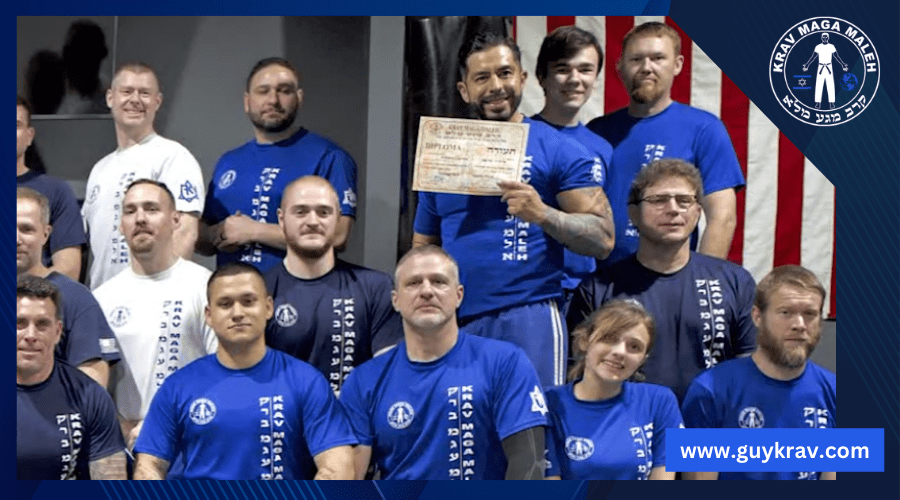
Incorporating Krav Maga Into Your Lifestyle
Balancing Training with Daily Life
Integrating Krav Maga into your daily routine can seem daunting at first, but with the right approach, it becomes a rewarding part of your life. Here’s how to maintain this balance:
- Prioritize Your Sessions: Treat your Krav Maga training like any important appointment. Schedule it in advance and avoid last-minute changes.
- Set Realistic Goals: Understand your time constraints and set achievable goals for your training. This keeps you motivated without feeling overwhelmed.
- Flexible Training Options: Look for classes that fit your schedule. Many Krav Maga schools offer sessions at different times throughout the day.
The Community Aspect of Krav Maga Training
One of the most enriching aspects of Krav Maga is the sense of community it fosters. Here’s what makes the community so special:
- Shared Goals: Training alongside others who share your goals of self-improvement and self-defense creates a strong bond.
- Support and Encouragement: The Krav Maga community is known for its supportive nature. Fellow students and instructors are there to encourage you every step of the way.
- Learning Together: As you train with others, you learn from their experiences and insights, which can enhance your understanding and skills.
Incorporating Krav Maga into your lifestyle not only improves your physical fitness and self-defense skills but also enriches your life with new friendships and a supportive community. It’s about finding a balance that works for you and embracing the journey with others who share your path.
Advanced Training and Specializations
As Krav Maga practitioners progress, opportunities for advanced training and specializations become available. These opportunities allow students to deepen their expertise, tailor their learning to specific interests, and even prepare for roles such as instructors. Here’s a closer look at what advanced training entails:
Deepening Technical Skills
Advanced training focuses on refining and mastering complex techniques. This includes:
- Precision in Execution: Advanced students work on the accuracy and efficiency of each move, ensuring they can execute techniques flawlessly under pressure.
- Advanced Defensive Tactics: Training includes defense against multiple attackers and assailants armed with firearms or knives, emphasizing situational awareness and quick decision-making.
- Counterattacks: Students learn to deliver powerful counterattacks in various scenarios, improving their ability to neutralize threats swiftly.
Specialization Areas
Krav Maga offers several areas of specialization, allowing students to focus on aspects of the system that most interest them or align with their personal goals. These areas include:
- Weapons Defense: Specialized training in disarming and neutralizing threats involving firearms, knives, and other weapons.
- Ground Fighting: Although Krav Maga emphasizes staying on your feet, ground fighting specialization teaches practitioners how to defend themselves when taken to the ground.
- Instructor Training: For those interested in teaching Krav Maga, instructor courses provide the necessary skills and knowledge to train others effectively.
Preparing for Leadership Roles
Advanced training also prepares students for leadership roles within the Krav Maga community. This includes:
- Mentorship: Experienced practitioners often mentor newer students, sharing insights and offering support as they navigate their training journey.
- Teaching Skills: Beyond martial arts techniques, advanced students learn about lesson planning, student assessment, and class management to become effective instructors.
- Community Building: Advanced practitioners play a crucial role in fostering a positive and inclusive training environment, encouraging a sense of belonging among all members.
Advanced training and specializations in Krav Maga not only enhance a practitioner’s skills but also contribute to their personal growth and the strength of the Krav Maga community. Whether aiming to become a more proficient martial artist or to take on a teaching role, advanced training offers a path to achieving these goals.
Exploring Weapons Defense
In Krav Maga, weapons defense is a critical area of focus, preparing practitioners to handle real-life threats involving weapons. This specialized training covers:
- Disarming Techniques: Students learn how to disarm attackers wielding knives, guns, and other weapons, focusing on speed, efficiency, and safety.
- Situational Awareness: Emphasis is placed on being aware of your surroundings to identify potential threats before they escalate.
- Use of Improvised Weapons: Training also includes using everyday objects as improvised weapons for defense, enhancing a practitioner’s ability to adapt in various situations.
Specialized Training for Law Enforcement and Military
Krav Maga offers specialized training programs tailored for law enforcement and military personnel. These programs focus on the unique challenges faced by these professionals, including:
- Control and Restraint Techniques: For law enforcement, training includes techniques to control and restrain suspects without causing unnecessary harm.
- Combat and Battlefield Tactics: Military personnel receive training in close combat tactics and battlefield awareness to enhance their effectiveness in combat situations.
- Stress Management: Both law enforcement and military training programs emphasize managing stress and making quick decisions under high-pressure conditions.
These specialized training programs in Krav Maga not only equip law enforcement and military personnel with essential self-defense skills but also improve their operational effectiveness and safety.
The Significance of Understanding Krav Maga Levels
Understanding Krav Maga levels is more than just knowing the belt colors or the techniques required for each stage. It’s about recognizing the journey of learning and growth that each practitioner undergoes. This journey is not just physical but also mental and emotional, challenging individuals to push beyond their limits and discover their true potential.
- Personal Growth: Each level in Krav Maga represents a milestone in personal development. As practitioners progress, they not only improve their physical abilities but also gain confidence, discipline, and resilience.
- Preparedness for Real-Life Situations: The structured approach to learning through levels ensures that practitioners are well-prepared to defend themselves and others in various situations, making Krav Maga a practical and valuable skill.
- Community and Support: The journey through Krav Maga levels is not taken alone. It’s supported by a community of instructors and fellow practitioners who provide guidance, encouragement, and camaraderie.
The significance of understanding Krav Maga levels lies in the comprehensive development it offers. From the foundational techniques learned as a beginner to the advanced tactics and leadership skills acquired at higher levels, Krav Maga equips individuals with the tools they need for self-defense, physical fitness, and personal growth. The journey of learning and growth in Krav Maga is a testament to the art’s depth, its practical application in real life, and its ability to transform lives.
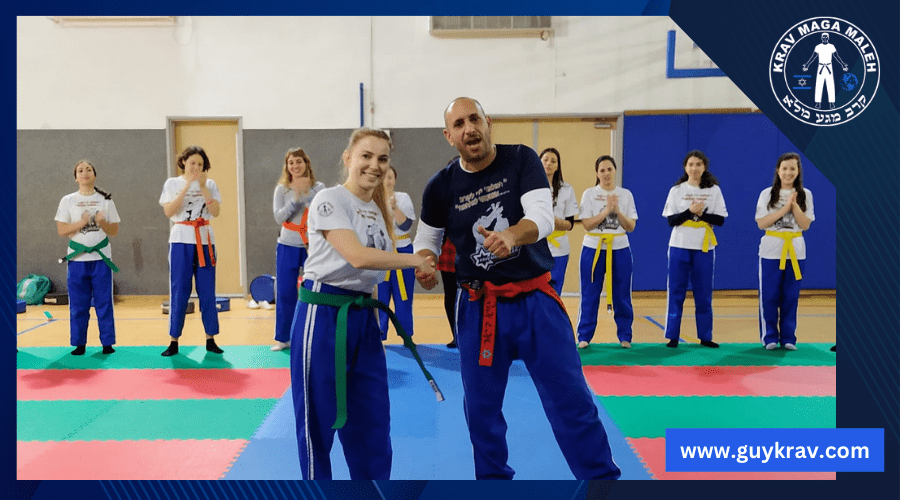
Frequently Asked Questions
How do I start with Krav Maga?
Starting Krav Maga is simple and exciting. First, find a local gym or training center that offers Krav Maga classes. Look for one with certified instructors and a welcoming environment. It’s a good idea to visit the center, meet the instructors, and possibly watch a class to get a feel for the training style. Most places offer beginner classes or introductory sessions, which are perfect for newcomers. These initial classes focus on basic techniques and principles, providing a solid foundation for your Krav Maga journey. Remember, no prior martial arts experience is needed to start Krav Maga. Just bring your enthusiasm and a willingness to learn.
What is the time commitment to advance in Krav Maga levels?
Advancing through Krav Maga levels varies by individual, depending on factors like the frequency of training, physical condition, and ability to grasp techniques. On average, moving from one level to the next can take anywhere from a few months to a year. Consistent practice, at least two to three times a week, is key to progress. Additionally, attending seminars, extra training sessions, and practicing outside of class can significantly enhance your learning speed. The journey through Krav Maga is personal and unique to each practitioner, with dedication and perseverance being crucial elements of success.
Can previous martial arts experience help in Krav Maga?
Yes, previous martial arts experience can be beneficial in Krav Maga. It can provide a solid foundation in terms of discipline, flexibility, and understanding basic combat principles. However, Krav Maga is unique in its approach and techniques, focusing on practical self-defense and real-world scenarios. Even with prior experience, beginners should approach Krav Maga with an open mind, ready to learn and adapt to its specific strategies and methodologies. The transition might require unlearning certain habits to fully embrace Krav Maga’s efficiency and directness.
What are the physical benefits of Krav Maga?
Krav Maga offers numerous physical benefits, making it a comprehensive workout. It improves cardiovascular health, strength, flexibility, and endurance. The dynamic movements and high-intensity drills boost your heart rate, promoting fat loss and improved heart health. Strength training elements build muscle and enhance overall body strength. Regular practice also increases flexibility and mobility, reducing the risk of injury. Additionally, Krav Maga enhances coordination and agility, making you more adept in physical activities both inside and outside the training center.
How does Krav Maga training adapt for different age groups?
Krav Maga is adaptable and suitable for all ages, with programs tailored to meet the specific needs and capabilities of different age groups. For children and teens, the focus is on building confidence, discipline, and basic self-defense skills, presented in a fun and engaging way. Adult classes are more intensive, with a strong emphasis on physical conditioning, advanced techniques, and real-world self-defense scenarios. For older adults, training is modified to accommodate physical limitations, focusing on techniques that require less physical strength and more on strategy and efficiency. Instructors are skilled at adjusting the training intensity and techniques to ensure everyone, regardless of age, can benefit from Krav Maga.
Discover Krav Maga at Krav Maga Maleh in Ramat Gan, Israel
At Krav Maga Maleh, we’re dedicated to offering top-notch Krav Maga training that empowers individuals of all ages and skill levels. Our comprehensive program, designed around the principles of self-defense, fitness, and personal growth, ensures that every student can achieve their full potential. Whether you’re starting your journey in Krav Maga or looking to advance to higher levels, our experienced instructors in Ramat Gan, Israel, are here to guide you every step of the way. Join our community and experience the transformative power of Krav Maga, where you’ll not only learn to defend yourself but also gain confidence, strength, and resilience. Start your Krav Maga journey with us today and unlock your true potential.

